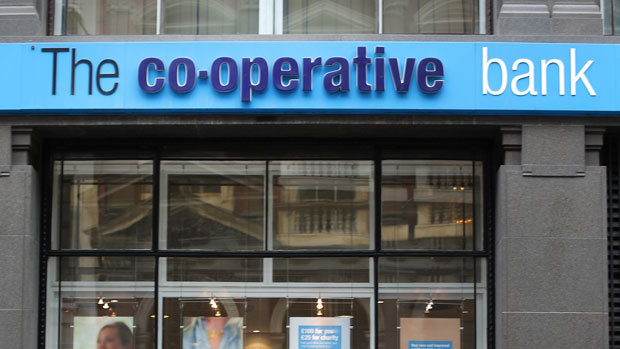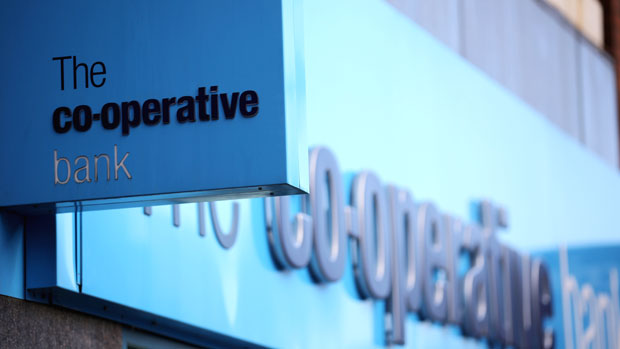Is the Co-op Bank heading for a merger?
Boss admits stockmarket listing is some way off as losses likely to continue for two years

The Co-operative Bank may soon join the wave of consolidation among so-called 'challenger' banks after its chief executive admitted it was likely to make losses for a further two years and was some way away from being ready for a stockmarket listing.Results published on Thursday showed the bank's losses nearly trebled from £77m to £204m in the first six months of the year. That was slightly better than expected, the Daily Telegraph reports, but the struggle to turn a profit underlines "the depth of the crisis at the ethically focused high-street lender".The group is rebuilding itself after nearly collapsing in 2012 amid allegations of serious mismanagement. The BBC notes that the banking division contributed £2.1bn of Co-operative Group's record losses of £2.3bn in 2013.The bank was rescued in a refinancing under which hedge funds took an 80 per cent stake in the business. According to Reuters these investors had planned a quick listing to generate a return, but this was put on hold when "it required a further 400 million capital injection".Chief executive Niall Booker has now kicked the prospect further into the long grass after he told reporters the bank was unlikely to pursue a float until its turnaround is "further advanced" and it is "closer to profitability". But losses will continue both this year and next, he added.Instead the bank may follow in the footsteps of TSB, the brand spun out from Lloyds as a standalone company after a sale to the Co-op fell through, and merge with a rival to create a larger player. Booker had raised that possibility in an interview with the Financial Times earlier this year and reiterated it in the wake of the latest results.
Now that its troubles are receding, Co-op may attract interest from rival groups. The BBC's business editor Kamal Ahmed notes that the bank has improved its capital position by selling off higher-risk loans, raising its interest rate margins (the difference between the rate it charges on loans and gives away to account holders) and stemming the outflow of customers from 60,000 in the first half of last year to closer to 2,000.
Co-op could end pursuit of 'Crystal Methodist' payout
19 August
The Week
Escape your echo chamber. Get the facts behind the news, plus analysis from multiple perspectives.

Sign up for The Week's Free Newsletters
From our morning news briefing to a weekly Good News Newsletter, get the best of The Week delivered directly to your inbox.
From our morning news briefing to a weekly Good News Newsletter, get the best of The Week delivered directly to your inbox.
Co-operative Group could be set to end its pursuit of ex-Methodist minister Paul Flowers over a severance payment worth more than £30,000, amid concerns legal costs could exceed the amount it would eventually recover.
The disgraced former non-executive chairman of Co-operative Bank, who was dubbed the "crystal Methodist" by the Daily Mail after he was allegedly caught buying and taking illegal drugs, received £31,000 in 2013 as the first instalment of a £155,000 severance package awarded in lieu of notice, Sky News reports.
Remaining instalments were halted once the drug allegations surfaced, but despite requests the initial payment has never been returned. Now there are fears that taking legal action to recover the money could actually cost more than the amount at stake if Flowers is found to be suffering from financial hardship. Insiders at the bank said a final decision has not been taken.
In a statement Co-op Group, which was responsible for his payment as it wholly owned Co-op Bank at the time, said it continues "to believe that Paul Flowers should repay" the amount and that there are "still have options open to us to recover the money". But Co-op must "spend our members’ money wisely and balance the costs we would incur to get the money back against what we would be likely to recover".
A free daily email with the biggest news stories of the day – and the best features from TheWeek.com
Co-op Bank was the only UK lender to fail regulatory 'stress tests' earlier this year as it continues to rebuild its capital base after its near collapse in 2012. Last week regulators waived more than £120m in fines that would have been due in relation to charges that it misled investors and failed to manage risks.
Co-op Bank given chance to rebuild as £120m fine waived
11 August
Co-operative Bank has been given a second chance by the UK's financial regulators despite a dual investigation uncovering extensive failings.
The Bank of England's Prudential Regulation Authority (PRA), which regulates banks and other systemically important financial institutions, says the bank had operated with inadequate risk controls for four years between 2009 and 2013 and had failed to be open with regulators by not disclosing two senior management changes in 2012 and 2013. It says the misconduct would have resulted in a £120m penalty.
Publishing the findings of its concurrent probe, the Financial Conduct Authority (FCA) says the bank breached listing rules by telling investors in a report in March 2013 that it was able to meet capital reserve requirements, when in fact it was not. It also cited the failure to be transparent over the management changes and the "reasons behind those changes". The FCA says the wrongdoing would "normally merit a substantial fine".
Both regulators decided against handing down fines because the Co-op Bank is "engaged in a plan" to ensure it meets its reserve requirements and has "adequate capital to withstand a severe stress". It was the only bank in the UK to fail regulatory stress tests in December.
The investigations had begun two years ago, after a £1.5bn hole was discovered on the bank's balance sheet and it was forced to raise money from hedge funds in a refinancing that reduced the Co-operative Group's stake to 20 per cent.
Sky News, which broke the story of the fine waivers, notes the crisis ended plans to acquire branches from Lloyds Banking Group which have since been spun out to form TSB Bank and could still result in Co-op Bank being "folded into another UK high street lender".
The FCA and PRA said investigations into senior individuals who ran the bank during its troubled period, including the former chairman and Methodist minister Paul Flowers, dubbed the "Crystal Methodist" by tabloids after drug-taking allegations, are ongoing.
Co-op Bank's Britannia merger was 'major cause of downfall'
30 April 2014
THE Co-operative Bank's merger with Britannia Building Society five years ago "should probably never have happened", according to a report into the Co-op crisis.
The "damning" review by former civil servant Sir Christopher Kelly has torn into the Co-op Bank's former management and board, exposing basic failures in virtually every aspect of the business, reports the Financial Times.
The Co-op commissioned the review after a £1.5bn capital shortfall was exposed in June last year. Published today, it tells "a sorry story of failings on a number of levels", says Kelly.
He describes the merger of the Co-op Bank with Britannia in August 2009 as a "major source" of its subsequent difficulties. Co-op Bank ignored the limitations of its size, talent pool and location and became "saddled with a substantial volume of assets well outside its risk appetite", it said.
Kelly added: "It might have worked if the merged organisation had received first class leadership. Sadly it did not."
The report was based on more than 130 interviews with current and former employees – although Kelly notes that Paul Flowers, the former Co-op Bank chairman, who was charged with drug possession earlier this month, refused to meet with him.
It highlighted a number of failures by the bank's executive, as well as the Co-op Banking Group Board. "Collectively, they failed to ensure that the Co-operative Bank consistently lived up to its ethical principles. In all these things they badly let down the Group's members," said Kelly.
The report said that "at no time" between the Britannia merger in 2009 and spring 2013 did the Co-op Bank have a chief executive with appropriate experience.
Kelly concluded the report with a number of lessons, such as recognising the complexities of running a bank and having the most suitable executive team. But he added that most of the lessons "are not new" and it "does no credit to those involved that they must be learnt again".
-
 Antibiotic resistance: the hidden danger on Ukraine’s frontlines
Antibiotic resistance: the hidden danger on Ukraine’s frontlinesUnder The Radar Threat is spreading beyond war zones to the ‘doorstep’ of western Europe
-
 ‘Capitalism: A Global History’ by Sven Beckert and ‘American Canto’ by Olivia Nuzzi
‘Capitalism: A Global History’ by Sven Beckert and ‘American Canto’ by Olivia NuzziFeature A consummate history of capitalism and a memoir from the journalist who fell in love with RFK Jr.
-
 Who will the new limits on student loans affect?
Who will the new limits on student loans affect?The Explainer The Trump administration is imposing new limits for federal student loans starting on July 1, 2026
-
 Has the Co-op Bank secured its future?
Has the Co-op Bank secured its future?In Depth It might sound like history repeating itself, but a fresh hedge fund deal could be the start of a new era
-
 Co-op's losses narrow thanks to 'very loyal' customers
Co-op's losses narrow thanks to 'very loyal' customersIn Depth Bank boss 'extremely grateful' to current account clients for staying
-
 Co-op Group: urgent reform needed to avoid ‘grave harm’
Co-op Group: urgent reform needed to avoid ‘grave harm’Speed Read Governance structure at the Co-op has ‘lamentably failed’, says former City minister Lord Myners
-
 Co-op Bank 'sorry' for £1.3bn loss and £400m black hole
Co-op Bank 'sorry' for £1.3bn loss and £400m black holeSpeed Read The head of the crisis-hit Co-op Bank was paid £1.7m for six months' work in 2013
-
 Euan Sutherland resigns from 'ungovernable' Co-op Group
Euan Sutherland resigns from 'ungovernable' Co-op GroupSpeed Read Chief executive Euan Sutherland has stepped down, blaming a lack of ‘professional and commercial governance.